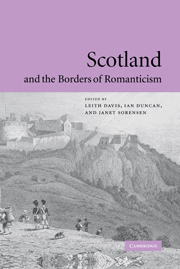Book contents
- Frontmatter
- Contents
- List of contributors
- Acknowledgments
- Introduction
- 1 Coleridge, Hume, and the chains of the Romantic imagination
- 2 The pathos of abstraction: Adam Smith, Ossian, and Samuel Johnson
- 3 Antiquarianism, the Scottish Science of Man, and the emergence of modern disciplinarity
- 4 Melancholy, memory, and the “narrative situation” of history in post-Enlightenment Scotland
- 5 Scott, the Scottish Enlightenment, and Romantic Orientalism
- 6 Walter Scott's Romantic postmodernity
- 7 Putting down the Rising
- 8 Joanna Baillie stages the nation
- 9 William Wordsworth and William Cobbett: Scotch travel and British reform
- 10 Burns's topographies
- 11 At “sang about”: Scottish song and the challenge to British culture
- 12 Romantic spinstrelsy: Anne Bannerman and the sexual politics of the ballad
- 13 “The fause nourice sang”: childhood, child murder, and the formalism of the Scottish ballad revival
- Index
13 - “The fause nourice sang”: childhood, child murder, and the formalism of the Scottish ballad revival
Published online by Cambridge University Press: 22 September 2009
- Frontmatter
- Contents
- List of contributors
- Acknowledgments
- Introduction
- 1 Coleridge, Hume, and the chains of the Romantic imagination
- 2 The pathos of abstraction: Adam Smith, Ossian, and Samuel Johnson
- 3 Antiquarianism, the Scottish Science of Man, and the emergence of modern disciplinarity
- 4 Melancholy, memory, and the “narrative situation” of history in post-Enlightenment Scotland
- 5 Scott, the Scottish Enlightenment, and Romantic Orientalism
- 6 Walter Scott's Romantic postmodernity
- 7 Putting down the Rising
- 8 Joanna Baillie stages the nation
- 9 William Wordsworth and William Cobbett: Scotch travel and British reform
- 10 Burns's topographies
- 11 At “sang about”: Scottish song and the challenge to British culture
- 12 Romantic spinstrelsy: Anne Bannerman and the sexual politics of the ballad
- 13 “The fause nourice sang”: childhood, child murder, and the formalism of the Scottish ballad revival
- Index
Summary
In a 1787 letter, Walter Scott attributes his poetical pursuits to his lifelong love of “ballads and other romantic poems,” poems which he has “read or heard” from the “earliest period of [his] existence” as a “favourite, and sometimes as an exclusive gratification.” It would seem, however, that not all of Scott's beloved ballads provided gratification exclusively, for he continues:
I remember in my childhood when staying at Bath for my health with a kind aunt of mine, there was an Irish servant in the house where we lodged, and she once sung me two ballads which made a great impression on me at the time. One filled me with horror. It was about a mason who because he had not been paid for work he had done for a certain nobleman, when that lord was absent, conveyed himself into the castle with the assistance of a treacherous nurse and murdered the lady and her children with circumstances of great barbarity.
The ballad Scott describes here is “Lamkin,” one of the many Scottish ballads that contain an account of infanticide. In most versions of this ballad, a “false nurse” helps Lamkin achieve his revenge. Together, the nurse and the mason fatally wound the infant son so that its cries will bring the mother down the stairs to meet her own death. When the nobleman returns at the end of the ballad, he rights these wrongs by hanging, burning, or boiling Lamkin and the nurse to death.
- Type
- Chapter
- Information
- Scotland and the Borders of Romanticism , pp. 225 - 244Publisher: Cambridge University PressPrint publication year: 2004
- 1
- Cited by



